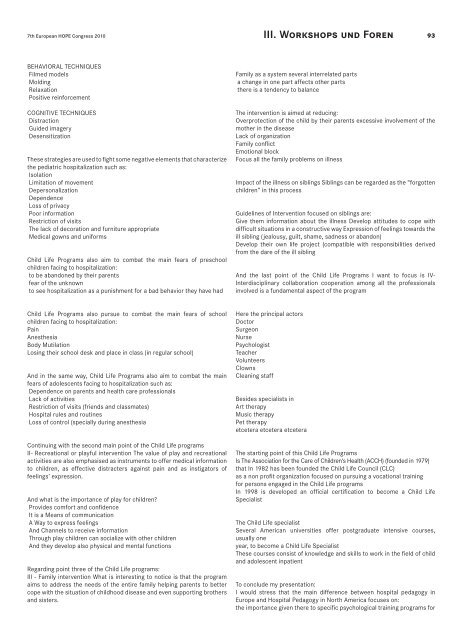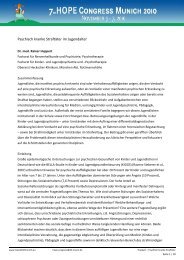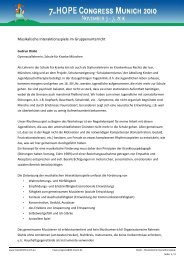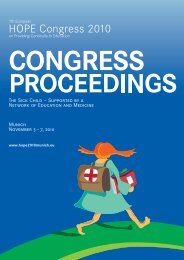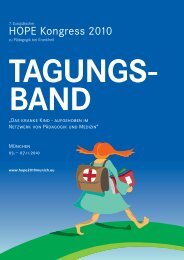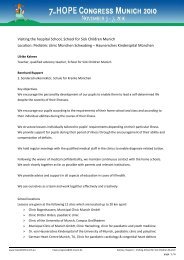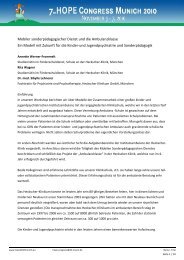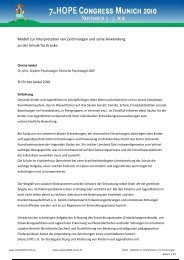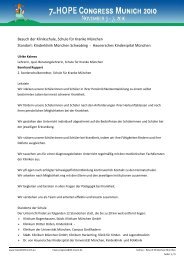HOPE Kongress 2010 - Hope Congress Munich 2010
HOPE Kongress 2010 - Hope Congress Munich 2010
HOPE Kongress 2010 - Hope Congress Munich 2010
Erfolgreiche ePaper selbst erstellen
Machen Sie aus Ihren PDF Publikationen ein blätterbares Flipbook mit unserer einzigartigen Google optimierten e-Paper Software.
7th European <strong>HOPE</strong> <strong>Congress</strong> <strong>2010</strong><br />
BEHAVIORAL TECHNIQUES<br />
Filmed models<br />
Molding<br />
Relaxation<br />
Positive reinforcement<br />
COGNITIVE TECHNIQUES<br />
Distraction<br />
Guided imagery<br />
Desensitization<br />
These strategies are used to fight some negative elements that characterize<br />
the pediatric hospitalization such as:<br />
Isolation<br />
Limitation of movement<br />
Depersonalization<br />
Dependence<br />
Loss of privacy<br />
Poor information<br />
Restriction of visits<br />
The lack of decoration and furniture appropriate<br />
Medical gowns and uniforms<br />
Child Life Programs also aim to combat the main fears of preschool<br />
children facing to hospitalization:<br />
to be abandoned by their parents<br />
fear of the unknown<br />
to see hospitalization as a punishment for a bad behavior they have had<br />
Child Life Programs also pursue to combat the main fears of school<br />
children facing to hospitalization:<br />
Pain<br />
Anesthesia<br />
Body Mutilation<br />
Losing their school desk and place in class (in regular school)<br />
And in the same way, Child Life Programs also aim to combat the main<br />
fears of adolescents facing to hospitalization such as:<br />
Dependence on parents and health care professionals<br />
Lack of activities<br />
Restriction of visits (friends and classmates)<br />
Hospital rules and routines<br />
Loss of control (specially during anesthesia<br />
Continuing with the second main point of the Child Life programs<br />
II- Recreational or playful intervention The value of play and recreational<br />
activities are also emphasised as instruments to offer medical information<br />
to children, as effective distracters against pain and as instigators of<br />
feelings’ expression.<br />
And what is the importance of play for children?<br />
Provides comfort and confidence<br />
It is a Means of communication<br />
A Way to express feelings<br />
And Channels to receive information<br />
Through play children can socialize with other children<br />
And they develop also physical and mental functions<br />
Regarding point three of the Child Life programs:<br />
III - Family intervention What is interesting to notice is that the program<br />
aims to address the needs of the entire family helping parents to better<br />
cope with the situation of childhood disease and even supporting brothers<br />
and sisters.<br />
III. Workshops und Foren<br />
Family as a system several interrelated parts<br />
a change in one part affects other parts<br />
there is a tendency to balance<br />
93<br />
The intervention is aimed at reducing:<br />
Overprotection of the child by their parents excessive involvement of the<br />
mother in the disease<br />
Lack of organization<br />
Family conflict<br />
Emotional block<br />
Focus all the family problems on illness<br />
Impact of the illness on siblings Siblings can be regarded as the “forgotten<br />
children” in this process<br />
Guidelines of Intervention focused on siblings are:<br />
Give them information about the illness Develop attitudes to cope with<br />
difficult situations in a constructive way Expression of feelings towards the<br />
ill sibling (jealousy, guilt, shame, sadness or abandon)<br />
Develop their own life project (compatible with responsibilities derived<br />
from the dare of the ill sibling<br />
And the last point of the Child Life Programs I want to focus is IV-<br />
Interdisciplinary collaboration cooperation among all the professionals<br />
involved is a fundamental aspect of the program<br />
Here the principal actors<br />
Doctor<br />
Surgeon<br />
Nurse<br />
Psychologist<br />
Teacher<br />
Volunteers<br />
Clowns<br />
Cleaning staff<br />
Besides specialists in<br />
Art therapy<br />
Music therapy<br />
Pet therapy<br />
etcetera etcetera etcetera<br />
The starting point of this Child Life Programs<br />
Is The Association for the Care of Children‘s Health (ACCH) (founded in 1979)<br />
that In 1982 has been founded the Child Life Council (CLC)<br />
as a non profit organization focused on pursuing a vocational training<br />
for persons engaged in the Child Life programs<br />
In 1998 is developed an official certification to become a Child Life<br />
Specialist<br />
The Child Life specialist<br />
Several American universities offer postgraduate intensive courses,<br />
usually one<br />
year, to become a Child Life Specialist<br />
These courses consist of knowledge and skills to work in the field of child<br />
and adolescent inpatient<br />
To conclude my presentation:<br />
I would stress that the main difference between hospital pedagogy in<br />
Europe and Hospital Pedagogy in North America focuses on:<br />
the importance given there to specific psychological training programs for


